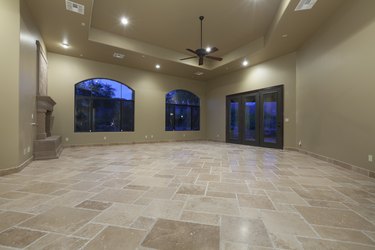
There is a slew of tile types from which to choose when redecorating or designing a personal space. Once past the usual suspects like granite, ceramic, marble and stone tiles, it can be a bit confusing. When spending precious pennies for honed and filled travertine tile for a space, you want to know exactly for what you are paying. There are a few reasons honed and filled travertine tile is a little more expensive than other types of tile, depending on the manufacturer.
Honed and Filled Travertine
Video of the Day
Honed and filled travertine is actually ground-down tile that has been treated. The travertine stone is naturally bumpy, with thick ridges and deep divots. When it is ground down, the colors tend to pop and the stone's beauty is revealed. It also makes for an easier path to traverse, particularly for large outdoor areas.
Video of the Day
Once the travertine is ground down, or honed, the rivers of narrow trenches and pockets of pock marks can be left to add charm and character. Often, the surface of the travertine is filled to create a smooth surface while not reducing the allure of the tile's divots and pits. The natural little dents and trenches are filled with cement or clear sealant so that the surface is smooth. Unfilled travertine has a few natural ridges and holes that are left behind in the treated tile for a more rustic look. Honed travertine can be a beautiful, economical and long-lasting addition to any room of the house.
Benefits of Travertine
There are many reasons honed travertine remains a solid design choice for DIYers and professionals. Tumbled travertine tile is durable and classic, standing the test of time as design trends come and go. They can withstand high-traffic areas beautifully, holding their rustic charm through season after season with little maintenance. If they somehow become cracked or damaged, they can be repaired quickly and easily without having to rip up the entire installation.
Honed and filled travertine does need a little more care and attention than other treated travertine tiles. The natural finish can scratch rather easily. Honed and filled travertine needs more protection from scrapes caused by furniture, luggage, shoes and everyday contact from hard household objects.
Travertine Maintenance Tips
Regular care and maintenance will keep honed and filled travertine in good shape for decades. Don't allow dirt and dust to gather on the surface of the tile or along the grout lines. Sweeping or dusting the tiles daily or at least weekly will significantly prolong the life of the stones.
For deeper cleaning, a commercial cleaner such as Mira Soap can add a beautiful patina to the stone as well as remove dirt, stains or mold that has taken root on the surface or in the grout. A simple solution of a gallon of warm water and a drop of dish-washing liquid can also clean the stone without damaging it or causing discoloration.
Travertine Stone Pavers
Travertine pavers come in a wide variety of shapes, sizes and shades, which is only one of the reasons they are so sought after by designers for both indoor and outdoor living spaces. Outdoors, travertine stone pavers are beneficial because they have a natural nonslip surface. They come in myriad hues, from luscious creams and rich grays to deliciously warm golden and copper tones. The mottled and varied surfaces create a rustic style or a traditional, Old World look no matter the size of the tile that is laid down. Small pavers open up a tight space, while large tiles look elegant lined up along a wide expanse of patio.